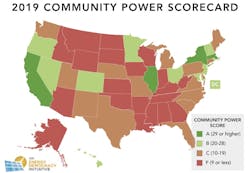Massachusetts, California, New York and Illinois are the top four states for energy democracy, as ranked by their commitment to boosting community-level renewable energy, according to a second annual Community Power Scorecard.
The scorecard, released by the Institute for Local Self-Reliance, names these states as stars because their energy policies promote clean energy wealth in communities.
“The goal is to enable and democratize distributed forms of energy,” said Marie Donahue, research associate, Institute for Local Self-Reliance.
Join us in San Diego, California for Microgrid 2019 May 14-16
Twenty states earned flunking scores because their policies don’t promote energy democracy, she said. The five rock-bottom flunkies were Louisiana, which earned 2 out of 38 possible points; and Alabama, South Dakota, North Dakota and Kansas, which also garnered low scores.
“The failing scores are in states that have not prioritized policies that enable local authority to expand ownership by the community in renewable energy,” she said. “They have no net metering and are graded poorly on how to get projects connected to the grid.”
States that require utilities to streamline clean energy producers’ connection to the grid get higher marks, she said.
Nine criteria for energy democracy
The rankings are based on the organization’s analysis of nine policies that promote citizen’s use of renewable energy and other distributed resources. Such policies provide wealth by creating jobs and allowing citizens and businesses to save money, earn income and protect the environment.
Policies recommended in the report card are customer-friendly net metering policies and simplified utility interconnection rules for distributed energy producers. The report authors also want to see more community renewable energy, energy supply diversity and financing programs, such on-bill financing and property assessed clean energy (PACE).
The organization favors utility investment in distributed energy. The scorecard also looked at whether policies allow communities to create strong building energy efficiency codes and provide for standard contracts for distributed energy, generally in the form of feed-in-tariffs.
Massachusetts, the top ranked state, received 32 out of 38 possible points, while California came close behind, with 31 points.
Massachusetts ranked high because it has many policies promoting local power, including net metering and a simplified interconnection process. The state offers PACE, requires that utilities include distributed resources in their mix, allows for community renewable energy, and allows communities can pick their energy suppliers.
In addition, Massachusetts allows communities to create building codes that are stronger than the state standard. What the state lacks, said the scorecard, is a standard contract for distributed energy projects and a residential PACE program. Standard contracts such as feed-in-tariffs provide certainty because they set prices and are generally long-term.
Flunkies
Louisiana and Alabama were at the bottom of the list, each with 2 out of 38 points.Louisaina received a passing grade for net metering, but flunked in all other categories.
Alabama has PACE, but no other programs to support the development of local renewable energy.
Effectively ranking how utilities compensate producers of distributed energy was a challenge, Donahue noted. “We relied on customer-friendly net metering scores for simplicity, but we will take a closer look at this in the future.” It makes sense to create a measure that incorporates non-market benefits such as environmental benefits, she said. In addition, more and more utilities are compensating producers for services such as demand management, but those programs weren’t included in the scorecard.
“We’re still trying to figure out how to wrap those compensation schemes into a cohesive score,” Donahue said.
The report card did not consider cap-and-trade programs or renewable portfolio standards. It was more focused on how state policies encourage consumers and businesses to generate their own power or participate in community solar programs.
“Unlike scorecards that evaluate state energy policies on a single statewide outcome or measure (e.g., 50 percent renewable by 2030), our community power score focuses instead on the way state policy enables communities to choose their path toward these goals,” said the scorecard.
Out with the old
Too often, state policymakers look at energy policy through the lens of the old monopoly model, said the scorecard.
One challenge is the transitory nature of policies, said Donahue. Sometimes states enact powerful policies, but they’re challenged or overturned.
State policymakers need to work harder to ensure policies create more certainty for producers, she said. “There’s an uncertain environment for how solar will be compensated years ahead.”
The scorecard pointed out big gains in certain states. For example, about 800,000 California rooftop solar producers provide the equivalent output of two nuclear power plants, said the scorecard. In Minnesota, people who take part in community solar projects produce enough to power 100,000 homes.
“These individuals, acting alone and collectively, are building the low-carbon 21st century electricity system,” said the scorecard.








